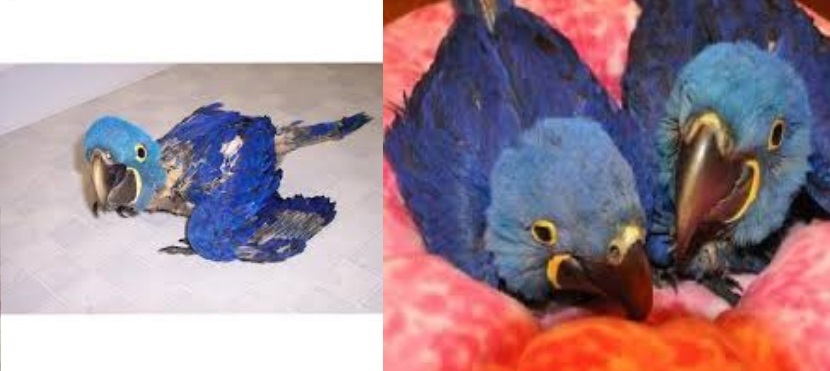Hyacinth Macaws
genus Anodorhynchus hyacinthinus

as of 2018, No Longer accepting reserves. We may be over reserved through 2026.
Description: Hyacinth Macaw
The Hyacinth Macaw can only be described as spectacular. The Hyacinth Macaw has been referred to as the "Rolls-Royce" of parrots and it's no surprise why. The largest of the parrot family, this blue beauty is a site to behold.
The Hyacinth Macaw, also called the
Hyacinthine Macaw or simply Hyacinth, is perhaps best known
for his brilliant cobalt blue plumage. In addition to being
beautiful, the Hyacinth Macaw has a sweet, charming
disposition. In spite of their size, the Hyacinth is gentle
with a very even-temperament. The Hyacinth Macaw is smart
and inquisitive. Those lucky enough to own these magnificent
birds need to make sure to provide them with lots of toys.
They are avid fans of chewing and can be quite destructive
if not given plenty of toys to play with.
The Hyacinth
Macaw is a member of the largest group of parrots in the
world - the Macaws. Of the Macaws, many would argue that the
Hyacinth is the most spectacular of all. The average
Hyacinth is 40 inches in length (100cm) and two and three
fourth pounds in weight (1,250G). Their wingspan reaches
nearly four feet in length. The hallmark of this macaw is
his plumage. The body of the Hyacinth is covered in rich,
deep cobalt blue feathers. The head of the Hyacinth Macaw
appears lighter in natural light, some describing it as
having an iridescent quality. The undersurface of the tail
and flight feathers is dark gray. Their bill is also dark
gray and is deeply curved, forming a sharp point. The face
of the Hyacinth Macaw has often been described as smiling;
this is due to the large vibrant yellow crescents around the
lower mandible. In addition to the yellow crescent, yellow
eye rings are also a feature of this stunning breed.
Immature Hyacinths have a notably shorter tail and a paler
upper mandible.
In the wild the Hyacinth is a social
bird seen in small flocks of six to twelve. Families are
usually easily distinguished in the flocks. Their native
diet includes nuts, berries, palm fruits such as
Astryocaryum tucuma, Acrocomia aculeata, Syagrus commosa,
Acrocomia lasiopatha, Attalea phalerata and Attalea
funifera, and other types of fruits.
The Hyacinth originates in South
America, and was first documented in 1790. They are commonly
seen in Paraguay, Brazil, Bolivia, and other areas. There
has been some debate over what their natural habitat is.
They seem to prefer fairly open areas with tall trees, as
opposed to the rainforest. They are also seen in marshes,
savannas, palm groves, and flood areas. Unfortunately, the
Hyacinth is becoming increasingly rare in the wild and is
now considered endangered. At one time the wild population
consisted of less than 4,000 birds. The main cause of this
decline is hunting, trade, and trapping. Today, however,
there have been several updated published studies, which
indicate that the wild population of Hyacinths in Brazil is
more likely to be upwards of 6500 or more. Because of the
successful efforts in conservation by several privately
funded groups, great measures have been taken to protect the
Hyacinths and crack down on illegal trade. This probably
accounts for the increase in numbers.















